How to Do Google Pixel Screen Mirroring [TV & PC]
Explore the comprehensive guide with AnyMiro to seamlessly do Google Pixel screen mirroring for an array of purposes.
Screen Mirror Tips
iPhone Screen Mirroring
Android Screen Mirroring
- One-for-All Guide: The Best Methods for Android Screen Mirroring
- How to Mirror Android to PC without Root
- How to Mirror Android to Windows 11 (Also Works for Win 10)
- [Easy] How to Mirror YouTube Videos from Android to PC
- Mirroring Made Easy: Best AirPlay Android Apps for Streaming
- Screen Mirroring App for Android: Everything You Need to Know
How to Do Google Pixel Screen Mirroring [TV & PC]
Try AnyMiro to do Google Pixel Screen Mirror.
- Fast response time within 10 ms and 60fps frame rate.
- A stunning visual experience with no color difference.
- Lag-free screen mirroring and 4k resolution.
Available for both Win & Mac
Google Pixel is a smartphone series by Google, running Android with seamless integration of Google services for an unaltered Android experience. While Google Pixel screen mirroring- a built-in function of the phone, lets you project your Google Pixel’s content on the screen onto other devices such as TVs and monitors. Do you know how to do Google Pixel screen mirroring? However, this built-in feature may have limitations like delays and connectivity issues. Don’t worry about these problems after reading this article, which provides you with the practical know-how of screen mirroring.
Table of ContentsHide
Google Pixel Screen Mirroring to Computer
Mirroring your Google Pixel screen to a Windows or Mac computer brings practical advantages across different situations by enlarging your phone’s content on a more prominent display for enhanced usability. So you must find the best screen mirror apps for PC and TV. Here are realistic scenarios you may meet in the future to do Google Pixel screen mirroring:
- Work and Collaboration: In professional settings, mirroring facilitates sharing presentations, documents, and visuals during meetings, boosting interaction and engagement.
- Media Sharing and Streaming: Sharing photos, videos, and media becomes effortless with screen mirroring. You can exhibit memories, stream videos, or enjoy social media collectively, eliminating the need for everyone to huddle around a small screen.
- Gaming Enhancement: Gamers benefit by projecting mobile games to a computer screen.
- Content Creation and Editing: Content creators find screen mirroring useful for editing photos, videos, and graphics.
In a nutshell, Google Pixel screen mirroring to a Windows or Mac computer makes tasks more simple. This function can be achieved through the Android built-in screen mirroring feature. But this article provides you with another simple and easy way to connect your screen of the Google Pixel to a PC (both Windows and Mac) — AnyMiro.
AnyMiro is a powerful third-party software to enable any device to screen mirror. This screen mirror app is the best choice for you with underlying advantageous features:
- Simple but Powerful
Experience and the ease of Pixel screen mirroring on PC with AnyMiro. Enjoy a seamless connection via USB or Wi-Fi, combining simplicity and power in one solution. Share, present, and play effortlessly.
- Stable and Smooth
With AnyMiro, experience a robust mirroring connection, delivering up to 10 hours of uninterrupted mobile gaming or drawing streaming. Enjoy seamless screen visuals that flow effortlessly, delighting viewers with exceptional stream quality.
- Fit for Esports or Art Screen Mirroring
Screen mirroring is perfect for Esports and Art. Audiences will enjoy seamless screen mirroring.
- Clear and Lag-Free
Crystal-clear, lag-free screen mirroring for your devices. It will let you experience seamless connectivity with sharp visuals, ensuring a smooth mirroring experience without any delays.
Alright! Now you already know the general knowledge and advantages of AnyMiro. Then the text below will teach you how to use AnyMiro to do the Google Pixel screen mirroring on a PC by two methods.
Method 1. Mirror Google Pixel to Computer via USB Cable Connection
Step 1. Download and install AnyMiro on your computer.
Free Download for all windows & 100% safe Free Download for all mac & 100% safe
Free Download100% Clean & Safe
Step 2. Connect your Android device to your computer(via USB cable). Then choose Android to connect the device.
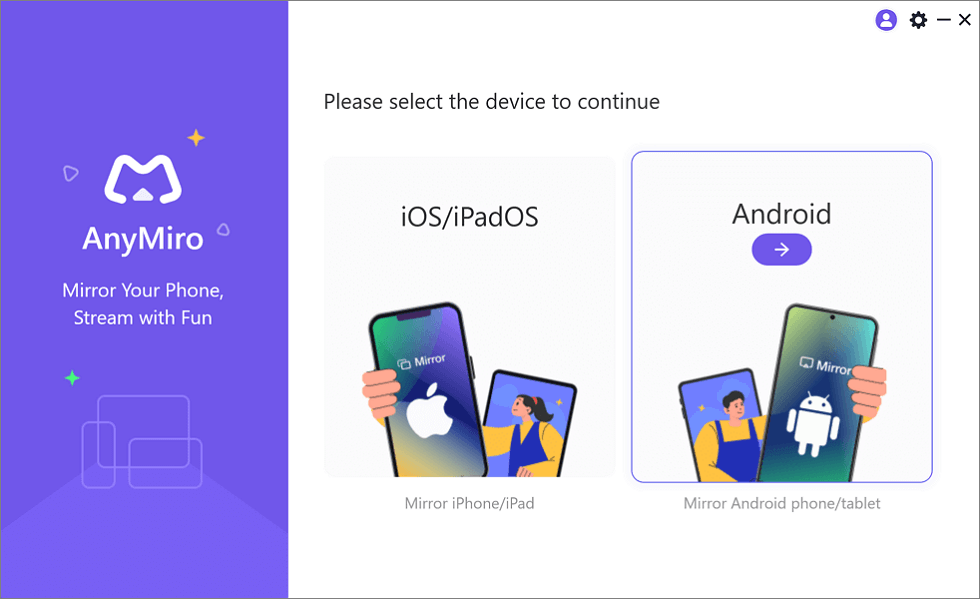
Mirror Android to Computer
Step 3. After that, please tap the USB icon and connect your Android device with a USB cable.

Mirror Android to Computer via USB
Step 4. Please turn on the USB debugging and choose the MTP Mode after you plug the USB cable.
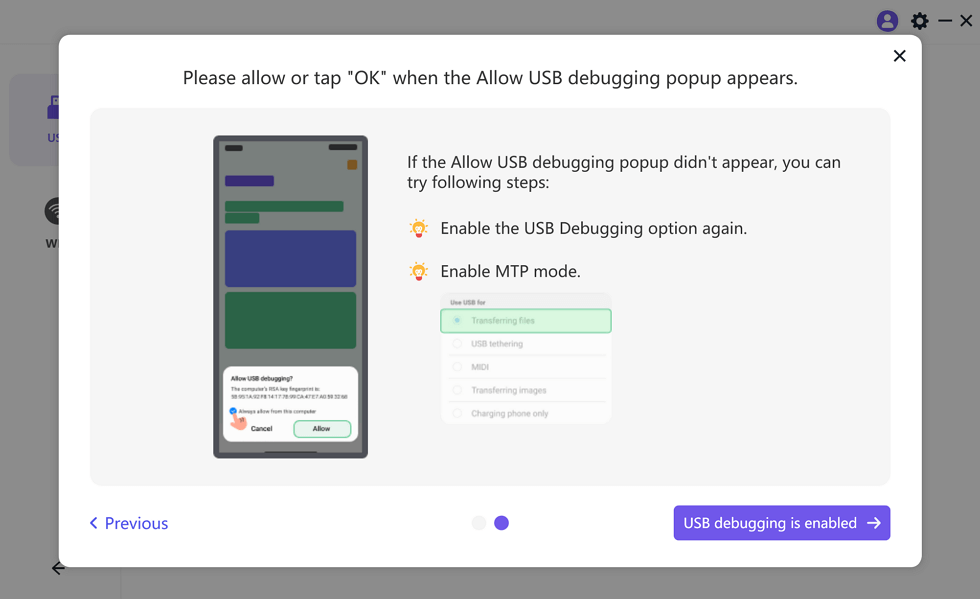
Enable USB Debugging and MTP Mode for a USB Connection
Step 5. Tap the USB connection on the AnyMiro app, and wait for a few seconds, you can see your Google Pixel screen on the computer.
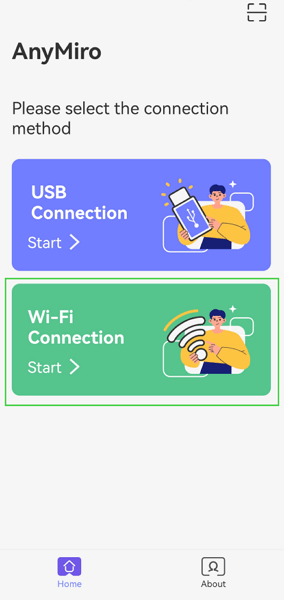
Select the Connection Method
After the Android device connects successfully, you will see the interface on your device. And it mirrored the Android device to the computer successfully.
Method 2. Mirror Google Pixel to Computer via Wi-Fi Connection
Step 1. Download and install AnyMiro on your computer.
Step 2. Connect your device to your computer (via Wi-Fi). Then select the Android option to connect the device.

Mirror Android to Computer
Step 3. Please click the Wi-Fi icon to connect your Android device with Wi-Fi.
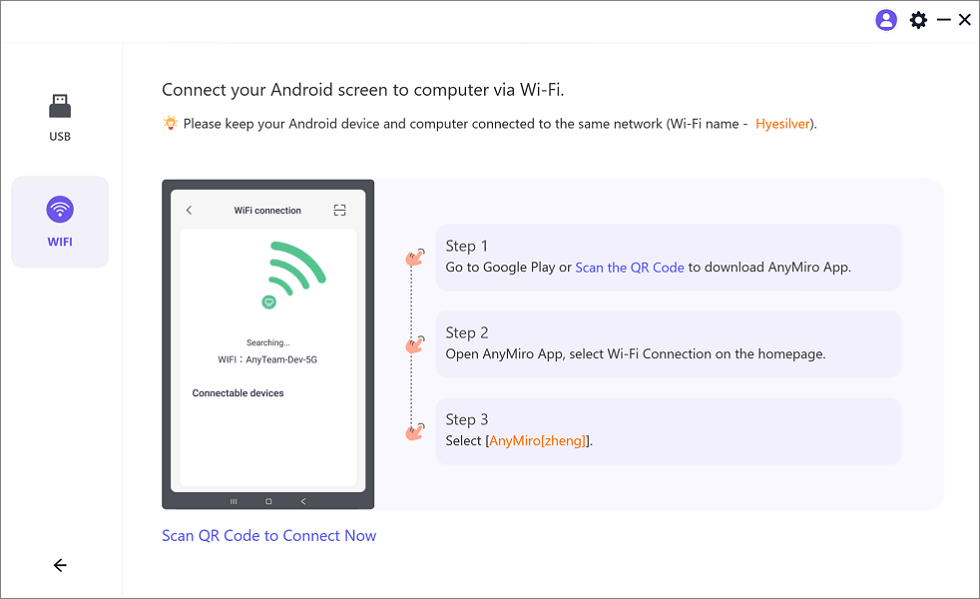
Mirror Android to Computer via WiFi
Step 4. Please go to Google Play and search AnyMiro or scan the QR code to download the AnyMiro App on an Android device.
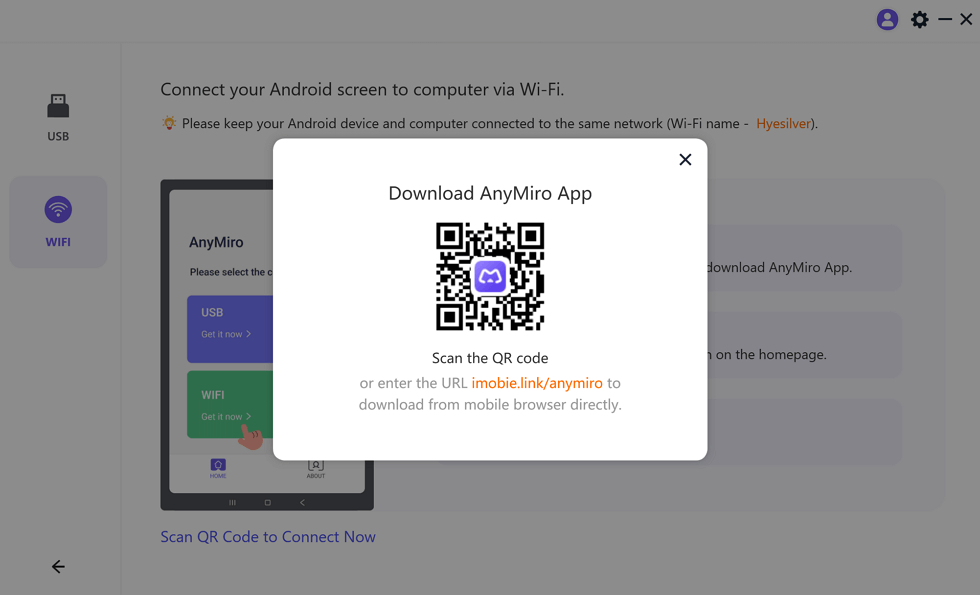
Download AnyMiro App on Your Phone
Step 5. Then, please open the AnyMiro App on the Android device and select Wi-Fi Connection on the home page.

Tap WiFi Connection
Step 6. Finally, please select the computer name you want to mirror.
Notice: Please keep your Android phone/tablet and computer connected to the same network.
Mirror Google Pixel Screen to TV
Screen Mirroring your Google Pixel to a Smart TV offers a versatile way to share, present, and enjoy content on a larger display. Here are common use cases:
- Media Sharing: Easily display photos, videos, and music from your Google Pixel to the Smart TV, perfect for sharing memories with friends and family.
- Streaming: Mirror streaming apps to enjoy your favorite shows and movies on a bigger screen for a more immersive viewing experience.
- Gaming: Play mobile games on the Smart TV for a larger-than-life gaming adventure, complete with improved visuals and controls.
- Presentations: Showcase presentations, documents, and slides to a wider audience during meetings or professional settings.
- Work Efficiency: View documents, emails, and calendars on the big screen to enhance productivity while working from your Google Pixel.
However, it’s important to note some limitations of Google Pixel screen mirroring to TV:
- Compatibility: Both your Google Pixel and the Smart TV must support the same screen mirroring technology, like Chromecast or Miracast.
- Connection Stability: The quality of the mirroring experience can vary based on the strength of your Wi-Fi network.
- Audio Delays: Some setups might experience audio delays when mirroring, affecting video synchronization.
- App Limitations: Certain apps may not support screen mirroring due to copyright or technical restrictions.
- Battery Drain: Extended screen mirroring sessions can drain your Google Pixel’s battery more quickly.
To overcome these limitations, ensure both devices are on the same network, and consider using a reliable screen mirroring device (e.g., Chromecast). Therefore, the text below will guide you to do Google Pixel screen mirroring through Chromecast.
Step 1. Link your Chromecast to your TV and confirm it shares the same Wi-Fi network as your Google Pixel device.
Step 2. Open the Google Home app on your Google Pixel.
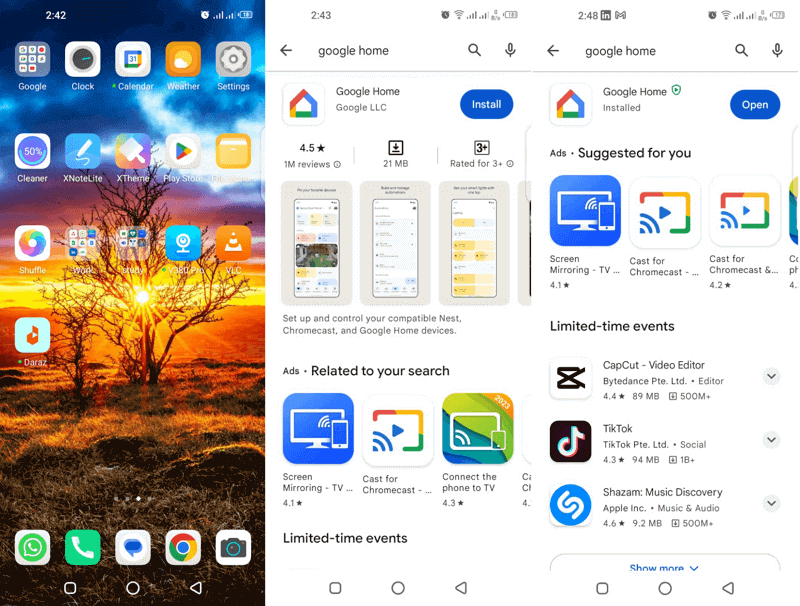
Install and Open Google Home on Your Device
Step 3. Tap on the Chromecast device to which you want to cast your screen.
Step 4. Tap the “Cast Screen” button.
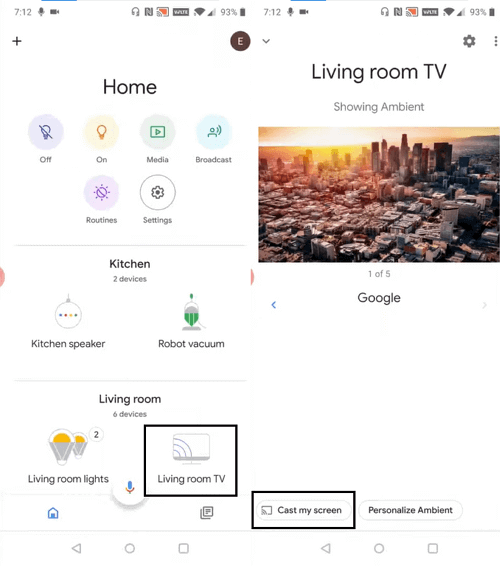
Cast Your Screen to TV Using Google Home
Step 5. Select your Chromecast device from the list, and tap “Start Now” to begin screen mirroring.
Mirror Google Pixel to TV Without Cast
If your TV lacks Cast features, consider a digital media player for the connection. Opt for a Chromecast if Pixel casting is desired. Connect it (or a compatible media player) to a TV HDMI port. Utilize in-app casting within supported apps like YouTube and Netflix. Follow the steps below for screen mirroring.
Step 1. Make sure both the Google Pixel and the TV are connected to the same Wi-Fi network.
Step 2. Swipe down from the top of the Pixel screen to reveal the Quick Settings menu. Swipe down a second time to reveal more settings.
Step 3. Select the Screen Cast option in the Quick Settings menu. If you do not see the Screen Cast option, tap the edit button (pencil icon) in the bottom right to reveal more setting tiles.
Step 4. Select Chromecast from the list of available Cast receivers that appear.
Step 5. Select “Start Now” if asked to start screen recording or casting.
FAQs about Google Pixel Screen Mirroring
1. How do I enable screen mirroring in Google Pixels?
- Step 1. Open your phone’s settings app.
- Step 2. Tap Connected devices > Connection preferences > Cast.
- Step 3. On the list, tap the device where you want to show your screen.
2. How to cast Google Pixel to Roku TV?
Ensure your Pixel and Roku share the same internet connection. On your Roku TV, navigate to Settings > System > Screen mirroring > Screen mirroring mode and set it to Prompt. For your Google Pixel, swipe down to access Quick Settings, tap the Cast icon, and pick your Roku TV from the device list. If prompted, enter the four-digit code displayed on your Roku TV screen to establish the connection. Once connected, your Pixel’s screen will mirror your Roku TV.
3. Can Pixel only Cast to Chromecast?
If you are attempting to cast to a device that does not have a Chromecast built-in or connected, you will not be able to cast or mirror from the Pixel to that device. If you have a smart TV, certain apps, like Netflix and YouTube, can be cast via DIAL if they are installed on both the TV and your Pixel. Or if you want to cast Pixel on PC, you can try other free screen-sharing software for PC.
4. Why can’t I screen mirror to Chromecast?
Ensure your Android phone and smart TV/monitor share the same Wi-Fi network. Different networks will hinder screen mirroring. Disable any active VPN on your phone or TV, as VPN alters the IP address and can disrupt screen casting.
The Bottom Line
Elevate your Google Pixel screen mirroring experience with AnyMiro – the ultimate solution that seamlessly combines simplicity, power, and stability. Now, it’s time to say goodbye to delays and disruptions when you explore our comprehensive guide, designed to effortlessly extend your Pixel’s capabilities to larger screens.
Product-related questions? Contact Our Support Team to Get Quick Solution >

